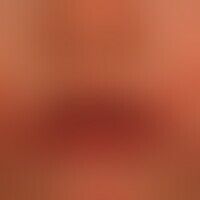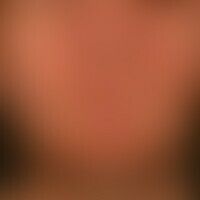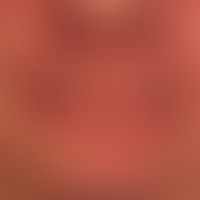Image diagnoses for "Face"
326 results with 947 images
Results forFace
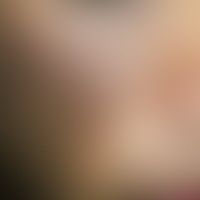
Nevus of Ota D22.30
Naevus fuscocoeruleus ophthalmomaxillaris. irregular, planar, brown to blackish blueish, half-sided pigmentation. half-sided manifestation running along the trigeminal nerve in the cheek area.

Actinic elastosis L57.4
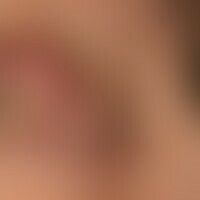
Giant keratoakanthoma D23.-
Giant keratoakanthoma: 6 cm in diameter large, painless lump, which initially grew very quickly, but now for several months no detectable size growth.
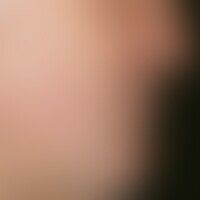
Tinea barbae B35.0
Tinea barbae. scaly, blurred, itchy erythema (incipient plaques) on the cheek and upper lip. erythema areas are sparsely interspersed with follicular papules and pustules.
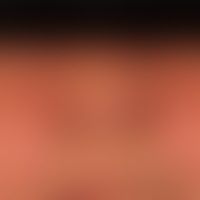
Crest syndrome M34.1
Crest syndrome,numerous telangiectases, sclerosis of the facial skin, periorbital radial wrinkles.
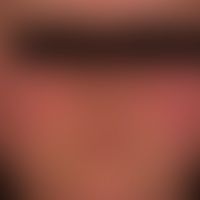
Rosacea L71.1; L71.8; L71.9;
rosacea. rosacea erythematosa, stage I of rosacea with individual inflammatory papules and pustules. flat, relatively sharply defined, symmetrical erythema (plaque) of the cheeks with clear protrusion of the follicles (skin pores). no comedones. perioral area remaining free. redness is now permanently present after earlier volatility but with varying intensity. at the same time, a feeling of tension and a slight burning sensation with shearing activity.
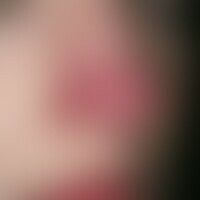
Rosacea L71.1; L71.8; L71.9;
Stage I-IIrosacea (rosacea papulopustulosa) In this 34-year-old female patient, single, recurrent red papules and pustules have been present on the nose, cheeks and chin for about 4 years.
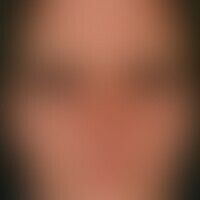
Folliculitis gramnegative L08.0
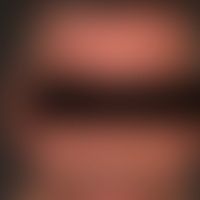
Psoriasis seborrhoic type L40.8
psoriasis seborrhoeic type: recurrent, location-constant and therapy-resistant "seborrhiasis" for several years. no like for atopic disease. extensive infestation of face and capillitium. itching and feeling of tension. note: in case of such an extensive infestation a systemic therapy is recommended (e.g. MTX, alternatively Fumarate).
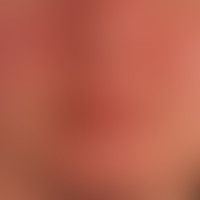
Mixed connective tissue disease M35.10
Mixed connective tissue disease: 43-year-old female patient (with clinical aspect of systemic lupus erythematosus) who fulfils the criteria of MCTD: U1.nRNP : titre : >1:1600; characteristics of systemic lupus erythematosus, Raynaud's phenomenon, swollen hands as well as feeling ill, fatigue, proximal muscle weakness (typical myositis symptoms).
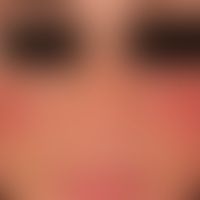
Rosacea papulopustulosa
Rosacea papulopustulosa: grouped, inflammatory reddened papules and pustules that persist for weeks in phases; variable feeling of tension in the facial skin.
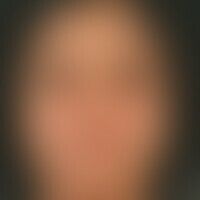
Seborrheic dermatitis of adults L21.9
Dermatitis, seborrhoeic. 6-month-old female patient with almost symmetrical, blurred, flatly infiltrated, scaly, non-itching red plaques. good clinical response to steroidal pre-treatment. recurrence of skin symptoms within a few days after discontinuation of therapy.
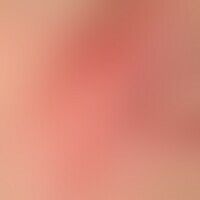
Erysipelas A46
Erysipelas. acutely appeared, blurred, laminar redness and swelling, on the right side nasal and paranasal in a 64-year-old woman; accompanied by a slight temperature rise and chills.

Eosinophilic pustular folliculitis L73.8
Pustulosis, sterile eosinophils, moderately itching, urticarial papules and plaques, papulovesicles grouped in the middle of the forehead.
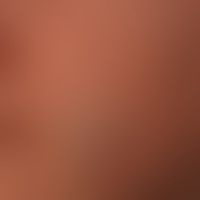
Hemangioma, cavernous D18.0
Venous malformation: Congenital subcutaneous, completely symptomless cavernous hemangioma.
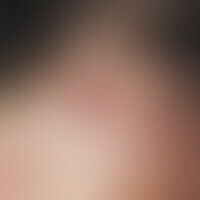
Angiomyxoma cutaneous D23.-
Myxoma, cutaneous. reddish rim of a papule with central crustal coating after evacuation of a mucous content in the area of the forehead hairline of a 36-year-old female patient.

Atrophy of the skin (overview)
atrophy. 63-year-old female patient with known porphyria cutanea tarda. evenly tanned facial skin. vertically running, sharp wrinkles of the forehead skin as well as deep, radial wrinkles of the perioral region. involution of the lip red.
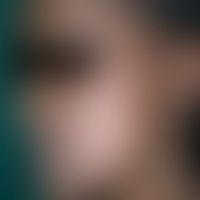
Acne papulopustulosa L70.9
Acne papulopustulosa: in acne-typical distribution, brown papules and papulo-pustules in different stages of development.
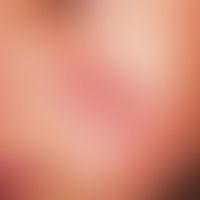
Leishmaniasis (overview) B55.-
Leishmaniasis, cutaneous (classic oriental bulge):roundish, reddish plaque appearing several weeks after a holiday in Mallorca with central erosion.
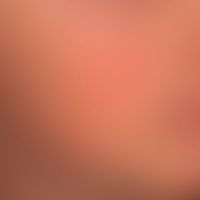
Erythema perstans faciei L53.83
Erythema perstans faciei: symmetrical, changing redness of both cheeks (here circled) Fixed erythema on chin and cheeks marked with arrows.
